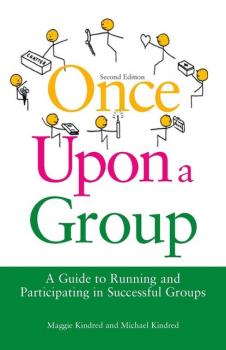Maggie Kindred
Список книг автора Maggie KindredOnce Upon a Group
Groups are a universal phenomenon, but their dynamics, make-up and customs can vary widely – a group can be anything from a family to a sports club. Having a good understanding of how groups work can make them more effective, enriching and fun. Once Upon A Group is a short, light-hearted guide to groupwork, providing an easily-digestible way of understanding group dynamics, the practicalities of running a group, and how to participate in one. It covers how and where to set up a group, including the type of room used, the size of the group and the arrangement of chairs, and the importance of boundaries and rules within a group. It also covers issues such as communication, sensitivity, listening, leadership, decision-making, labelling and stereotyping, and forms of participation, among many others. Each topic is illustrated with a lively drawing to communicate the ideas presented. This second edition also covers diversity throughout and how to apply the ideas in the book to different settings. Based on research but written in an instantly accessible style, this fun guide will be essential reading for all those involved in groupwork including health and social care practitioners, volunteers, advice workers, youth workers and students.
A Practical Guide to Working with Reluctant Clients in Health and Social Care
Practitioners in health and social care are often required to work with clients who do not want to work with them, and these 'reluctant' clients can often be the most challenging, but most rewarding, to work with. This practical, jargon-free book covers all the issues that practitioners are likely to encounter in the course of working with reluctant clients. The emphasis is on making theory easy to use, and the book is written in an easily digestible and lively style. Topics covered include staying safe, verbal and non-verbal communication, making initial contact with a client, crisis situations, recording, and how to end work with a client. Activities to work through are included at the end of each topic and illustrations feature throughout. This is an essential book for students, practitioners, voluntary sector workers and trainers in the fields of health, social care and social work.
500 Tips for Communicating with the Public
This is a light-hearted, easily digestible guide with a wealth of handy hints and tips for communicating with the public. For those in the helping professions, communicating with the public can sometimes be a challenge, and different skills are needed to those used when communicating with friends and family. This book addresses these issues by providing hundreds of tips on how to communicate with the public, covering topics such as managing conflict, assertiveness, feelings, listening and boundaries. It also includes guidance on reflection, supervision, confidentiality and anti-discrimination. The book uses a fun and accessible approach, making the advice easy to read and then put into practice. This handy guide will be invaluable to a range of practitioners in the helping professions including health visitors, social care workers, probation officers and teachers, as well as any other professional looking for tips on how to communicate effectively.


